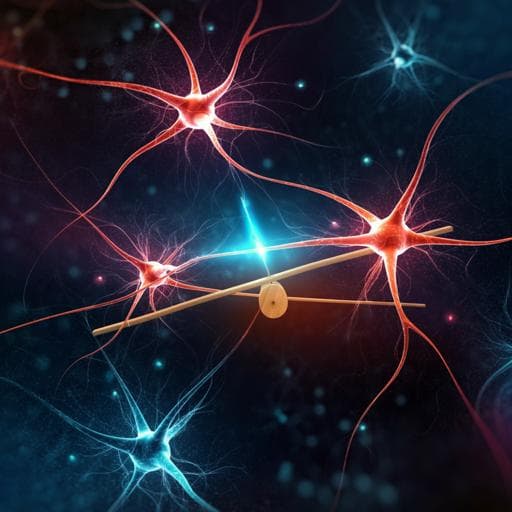
Medicine and Health
Orexin-A and endocannabinoids are involved in obesity-associated alteration of hippocampal neurogenesis, plasticity, and episodic memory in mice
N. Forte, S. Boccella, et al.
This groundbreaking study reveals how the interplay of orexin-A and endocannabinoid signaling contributes to hippocampal dysfunction in obesity. Conducted by a team of experts including Nicola Forte and Serena Boccella, it uncovers the molecular mechanisms behind memory impairments linked to obesity, paving the way for potential therapeutic interventions.
~3 min • Beginner • English
Introduction
The study investigates how obesity impairs episodic memory, specifically pattern separation (PS), a hippocampal function mediated by the dentate gyrus (DG) and its inputs to CA3. Adult hippocampal neurogenesis (AHN) in the DG contributes to PS and LTP. Obesity and high-fat diet (HFD) are associated with deficits in hippocampal-dependent tasks and altered AHN. Endocannabinoids (eCBs) regulate AHN and memory, and orexin-A (OxA) can stimulate 2-arachidonoylglycerol (2-AG) and CB1 receptor signaling via Ox1-R. Prior work showed orexinergic neuron disinhibition and increased OxA signaling in obese mice. The authors hypothesize that elevated OxA in obesity drives 2-AG/CB1 signaling to disrupt AHN-dependent synaptic plasticity at medial perforant path (MPP)-DG synapses, leading to impaired PS, and that Ox1-R antagonism can rescue these deficits.
Literature Review
Background literature links PS and hippocampal function (DG to CA3 transformations), with alterations in chronic pathologies such as Alzheimer’s and multiple sclerosis. AHN supports PS; its ablation impairs, and potentiation improves, performance on similarity discrimination tasks. Lifestyle factors like exercise and caloric restriction enhance AHN and cognition, while HFD and leptin receptor dysfunction reduce AHN and impair hippocampal tasks. The eCB system (CB1/CB2, 2-AG) promotes AHN; progenitors produce eCBs and express receptors. eCBs are implicated in episodic memory; cannabis can disrupt new memory formation. OxA, produced in lateral hypothalamus, regulates arousal and metabolism, can stimulate DAGLα-driven 2-AG synthesis and CB1 signaling, and influences hippocampal neurogenesis and plasticity. Obesity rewires LH orexin inputs leading to endocannabinoid-mediated disinhibition and excessive OxA output. These works frame a potential OxA–eCB crosstalk affecting hippocampal neurogenesis and PS in obesity.
Methodology
Animal models: Adult mice included wild-type lean mice on standard chow, HFD-fed mice, and leptin-deficient ob/ob mice. Behavioral assays were adapted to minimize anxiety/mobility confounds with extended handling/habituation.
- Light–dark box and open-field tests assessed baseline motor and anxiety-like behavior (automated tracking; standard apparatus; 10-min sessions).
- Pattern separation in Novel Object Recognition (NOR): After 2 weeks handling/familiarization, mice explored two identical objects (10 min). Short-delay (1.5 h) and long-delay (24 h) tests presented either similar objects (same color, different shape) or distinct objects (different color and shape). NOR index = (Tn–Tf)/Ttot; active exploration defined by sniffing/whisking. Object positions counterbalanced; arenas and objects cleaned between trials.
- Morris water maze: Reference memory version with visible platform day 1 (beacon training), hidden platform days 2–4 (North quadrant), probe trial (60 s) before goal reversal, then platform moved (South quadrant) with relearning days 5–6. Metrics: latency, path length, time in quadrants, goal crossings, latency to first goal entry, path efficiency; ANY-MAZE tracking.
Neurogenesis and histology:
- Immunohistochemistry in DG: Quantitative stereology of proliferating cells (Ki67), immature neurons (DCX), early differentiation marker (NeuroD). Dendritic development and synaptic integration of DCX+ cells assessed by PSD95/DCX colocalization in IML/MML.
- Confocal colocalization: DCX/OxA/CB1, CB1/VGluT1, DCX/PSD95/CB1, DCX/PSD95/NR2B to map orexinergic/eCB signaling and synapse markers in IML–MML.
- Correlative light and electron microscopy (CLEM) in POMC-eGFP mice: Double immunogold labeling for Ox1-R, OxA, CB1, DAGLα at asymmetrical synapses onto newborn granule cell spines; ultrathin sections imaged by TEM.
Electrophysiology:
- In vitro LTP: Horizontal hippocampal slices (400 µm). Field EPSPs recorded in DG molecular layer with MPP stimulation; paired-pulse depression used to identify MPP. LTP evoked by four 100 Hz trains; neurogenesis-dependent LTP assessed without GABAA blockade. Pharmacology: OxA (100–200 nM), Ox1-R antagonist SB334867 (10 µM), CB1 antagonist AM251 (4 µM), DAGL inhibitor O-7460 (10 µM), CB1 agonist ACEA (125 nM).
- In vivo LTP: Urethane-anesthetized mice with stimulating electrode in MPP and recording in DG ML; TBS protocol (six trains; bursts at 400 Hz). Microinjections into MPP: SB334867 (0.1 nmol/0.5 µl) or AM251 (0.5 nmol/0.5 µl).
Biochemistry:
- Hippocampal OxA ELISA after vehicle, OxA (40 µg/kg i.p.), leptin (5 mg/kg i.p.) treatments; comparison across lean, HFD, ob/ob.
- DG 2-AG quantification by LC-APCI-MS: Lean ± OxA (40 µg/kg) ± SB334867 (30 mg/kg), HFD ± SB, ob/ob ± SB.
- Western blot: NR2B (NMDAR2B) levels in hippocampus of lean, HFD, ob/ob ± leptin; normalized to α-tubulin.
Cell culture:
- Human iPSC-derived neural stem cells (NSCs): Treatments with OxA (50–200 nM), SB334867 (10 µM), O-7460 (10 µM), alone or combined; DCX immunocytochemistry after 72 h to quantify neuronal differentiation and neurite branching.
Statistics: Normality tested; one-way or two-way ANOVA with Bonferroni/Tukey post hoc, Kruskal–Wallis with Dunn’s post hoc, repeated-measures ANOVA where appropriate. Significance p < 0.05. Data presented as box plots with individual datapoints or mean ± SEM.
Key Findings
- Behavioral PS deficits in obesity: In NOR with similar objects, obese mice failed to discriminate at 1.5 h (NOR index: lean 0.31 ± 0.03; HFD −0.04 ± 0.08; ob/ob 0.01 ± 0.05; n=10/group; Kruskal–Wallis, p<0.01). At 24 h, lean performed better than obese (lean 0.25 ± 0.03; HFD 0.07 ± 0.05; ob/ob −0.20 ± 0.12; p<0.05–0.01). With distinct objects, no deficits at 1.5 or 24 h.
- Water maze: Acquisition and probe quadrant preference intact in HFD, but reduced precision (goal crossings lean 10 ± 0.8 vs HFD 7.5 ± 0.7; path efficiency 0.5 ± 0.08 vs 0.3 ± 0.05; increased latency to first goal 7.9 ± 2.1 s vs 18.21 ± 3.7 s; all p<0.05) and impaired goal reversal learning (higher latency/path length on day 5; p≤0.05).
- AHN alterations: Proliferation reduced in obese (Ki67+ cells/section: lean 199 ± 3.6; HFD 170.1 ± 3.2; ob/ob 159.2 ± 3.5; p<0.0001). Neurodifferentiation increased (DCX+ cells: lean 172.17 ± 2.3; HFD 251.93 ± 3.4; ob/ob 262.20 ± 2.7; p<0.0001; NeuroD+ cells: lean 164 ± 2.3; HFD 298 ± 2; ob/ob 295.4 ± 1.1; p<0.0001). DCX dendrites showed greater maturation/branching in obese; PSD95/DCX colocalization in IML–MML increased (lean 19.53% ± 0.9%; HFD 34% ± 1.1%; ob/ob 29.77% ± 1.1%; p<0.0001).
- LTP deficits: In vitro ACSF-LTP at MPP–DG similar between genotypes. In vivo, TBS induced robust LTP in lean (251.4% ± 16.09%), but not in HFD (94.01% ± 8.03%) or ob/ob (103.55% ± 13.48%) (p<0.05), suggesting diffusible mediators washed out in slices.
- OxA elevation and effects: Hippocampal OxA doubled in obese vs lean and was normalized by leptin in ob/ob (pmol/mg: lean 4.82 ± 0.1; lean+OxA 10.10 ± 0.8; HFD 10.57 ± 0.2; ob/ob ~11; ob/ob+leptin 5.02 ± 0.1; F=222.1, p<0.0001). In slices, OxA 200 nM reduced LTP (to 91.83% ± 6.93%); SB334867 restored it (116.1% ± 7.02%; ANOVA F=4.90, p<0.05).
- OxA/eCB localization: CB1/DCX puncta abundant in IML–MML without group differences; OxA/DCX colocalization increased in obese (lean 14.63% ± 1.1%; HFD 30.50% ± 3.8%; ob/ob 34.6% ± 5.4%; p<0.0001). OxA immunodensity elevated in IML–MML of obese (lean 14.63% ± 2.1%; HFD 56.50% ± 6.8%; ob/ob 60.57% ± 6.4%; p<0.0001). CB1/VGluT1 colocalization high across groups (~74–78%).
- 2-AG increases and dependence on Ox1-R: DG 2-AG levels (pmol/mg) increased by OxA in lean and were reduced by SB334867, which also lowered elevated 2-AG in obese: lean 3.2 ± 0.5; lean+OxA 14.1 ± 1.4; lean+OxA+SB 4.3 ± 0.5; HFD 19.9 ± 0.6; HFD+SB 7.8 ± 0.6; ob/ob 18.9 ± 0.8; ob/ob+SB 8.1 ± 0.3 (F=84.35, p<0.0001).
- Ultrastructural evidence (CLEM): Newborn granule cell spines expressed Ox1-R and DAGLα postsynaptically apposed to OxA-containing terminals; DAGLα located near Ox1-R and CB1-positive presynaptic inputs at asymmetrical synapses in IML–MML.
- Mechanistic pharmacology: In slices, OxA-induced LTP impairment prevented by CB1 antagonism (AM251 4 µM; LTP 135.8% ± 14.73%) or DAGL inhibition (O-7460 10 µM; 121.1% ± 11.82%). CB1 agonist ACEA (125 nM) suppressed LTP (84.72% ± 6.05%; Kruskal–Wallis p<0.05).
- In vivo rescue of LTP: In HFD, MPP microinjection of SB334867 restored LTP (195.7% ± 30.39%), whereas AM251 had minimal effect (109.4% ± 4.7%; p<0.05). In ob/ob, both SB334867 and AM251 restored LTP (175.6% ± 3.77% and 190% ± 21.5%; p<0.05).
- NR2B differences: NR2B markedly reduced in ob/ob DG (~80% decrease vs lean; prevented by leptin), less so in HFD (non-significant), potentially explaining differential sensitivity to CB1 antagonism.
- Behavioral rescue of PS: Single SB334867 injection before NOR acquisition did not alter acquisition performance, but rescued short-term (1.5 h) discrimination of similar objects in obese mice (recognition index increased to 0.36 ± 0.07 in HFD and 0.42 ± 0.06 in ob/ob; p<0.01), not long-term (24 h) performance (HFD 0.02 ± 0.05; ob/ob −0.04 ± 0.06; F=8.6, p<0.01).
Discussion
The findings demonstrate that obesity elevates hippocampal orexin-A signaling, which via Ox1-R on newborn granule cell dendritic spines activates DAGLα-dependent 2-AG synthesis. 2-AG acts retrogradely on presynaptic CB1 receptors at MPP inputs to inhibit glutamate release, thereby impairing AHN-dependent LTP in DG and degrading pattern separation. The mechanistic chain is supported by convergent behavioral deficits in PS, cellular neurogenesis shifts (reduced proliferation with accelerated differentiation and synaptic integration), in vivo LTP loss (but preserved in vitro when diffusible factors are washed out), elevated OxA and 2-AG in DG, pharmacological blockade of Ox1-R/DAGL/CB1 restoring plasticity, and ultrastructural localization of Ox1-R, DAGLα, and CB1 at MPP–DG synapses on newborn neurons. Ox1-R antagonism restored in vivo LTP in both HFD and ob/ob mice and rescued short-term PS in NOR, indicating a causal role for OxA in early mnemonic processing deficits associated with obesity. Differences in NR2B levels between HFD and ob/ob may modulate 2-AG production and the efficacy of CB1 antagonism, aligning with leptin’s modulation of NR2B in ob/ob. Overall, the data link orexin–endocannabinoid crosstalk to hippocampal circuit dysfunction contributing to episodic memory alterations in obesity.
Conclusion
This work identifies an orexin-A/Ox1-R-driven 2-AG/CB1 signaling cascade at MPP–DG synapses onto newborn granule cells as a key mechanism underlying obesity-associated impairment of AHN-dependent LTP and pattern separation. Elevated OxA in obese mice increases 2-AG production via DAGLα, suppressing glutamatergic transmission and plasticity; antagonism of Ox1-R (and, context-dependently, CB1) restores synaptic plasticity and rescues short-term PS deficits. These findings provide a molecular framework connecting metabolic state to hippocampal memory encoding and suggest Ox1-R blockade as a potential therapeutic approach to mitigate episodic memory dysfunctions associated with obesity.
Limitations
Related Publications
Explore these studies to deepen your understanding of the subject.







